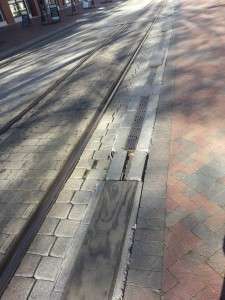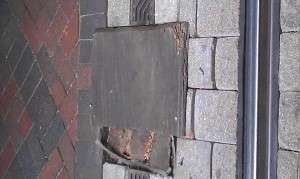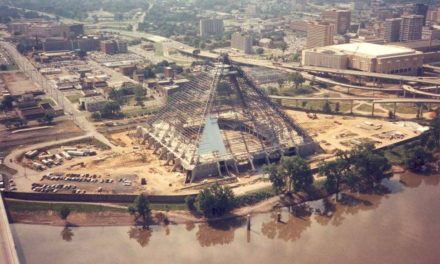To paraphrase a downtown leader, do you know of a “real” city whose Main Street looks like ours?
Do you know of a “real” city that leaves plywood patches to Main Street for more than a decade to the point that the wood repairs start decaying?
Do you know of a “real” city that would simply be content to allow Main Street to be a constant reminder of our own lack of self-worth?
Do you know of a “real” city that would allow its Main Street to tell every visitor that we just don’t “get” it?
How can we talk about being more than third-rate convention city when we send the message that the public sector is perfectly happy with a third-rate Main Street and a third-rate experience for tourists? How can we even talk about a new convention center when we can’t even get the basics right?
We know that some of you may think we’re verging on obsession when it comes to the deplorable condition of Main Street, but when you take an out-of-town visitor to lunch and you have to walk a block or two, you see our city through someone else’s eyes. We are in a word, embarrassed.
As you walk past repairs that would be rejected by a high school shop class, it is impossible to avoid multiple plywood repairs, broken drainage grates, and shattered tile dividers. From Poplar to Peabody Place, there are 59 plywood patches passing as repairs to broken grates on Main Street, and some of the plywood patches are eight feet long.
We’ve written before about the impact of the “intuitive city,” the city that registers on us subliminally before we’ve even consciously begun to for opinions about a city. The intuitive city responds to public art, public realm, and urban design. We can remember having positive feelings about Austin and we hadn’t even gotten out of the airport yet, because of the Austin-centric elements and designs. We remember the same feeling in Portland, Oregon, because of manhole covers that were designed by artists.
So, what is the intuitive city that we’re presenting to our visitors – and to our own residents – on Main Street?
To quote Malcolm X, if you don’t stand for something, you’ll fall for anything. If we won’t stand for a Main Street that represents the best that Memphis has to offer, maybe it’s why we have a history of falling for so many magic answers to our problems.
There’s a lot of long overdue, much-needed discussion these days about bringing more rationality to gun laws, but we were shocked the other day by a display of serious-looking knives being sold at Exxon’s Tiger Mart in downtown Memphis.







Where is the Mayor? The CEO of Memphis. Have these men no shame? Our city streets look like a third world hell hole.
All I have to say is amen. It depresses the hell out of me every time I come home. It is as if no one is in charge.
Just the other day I was showing an out-of-town investor/developer around Downtown attempting to convince him to invest in our city. It’s horribly damaging to our case when he notices that the city doesn’t even take proper care of its Main Street. We talk a lot about being a bike/ped friendly town, but for years we haven’t bothered to fix the few blocks in our city that are walked more by residents on a daily basis than any other block.
Help is on the way, though. We included repair of the Main Street Mall in our federal TIGER grant application for the Main-to-Main over the Harahan project. Design work is underway to fix Main from Uptown to South Main including especially the Mall.
Although the Harahan is the showy centerpiece that gets all the attention, fixing Main Street Mall was DMC’s primary objective in working for years to get a federal TIGER grant. We applied before just for Main Street and lost because the feds said the project wasn’t big enough, so then we hooked up with the Harahan Project to produce a winning application. Only 5% of apps nationwide won this latest TIGER round, and our $30M Main-to-Main Multimodal Connector Project was among the winners. Most of the money will be spent on and along Main Street in Downtown Memphis.
I walk to lunch every day, keeping an eye at my feet for the next walking hazard. The condition of our “Main” street or those that cross it says “I don’t care.” And I watch the tourists on the trolley, only imagining what they are thinking.
Paul et al.,
There are $30 million worth of needed improvements on Main Street in downtown Memphis alone. Seeing as the TIGER grant is being utilized over such an extensive route, I cannot help but notice that this funding will be spread as a thin veneer over the areas that are most in need. The Main to Main project runs the same risk as so many other projects in Memphis in that the funding in place is not adequate to carry us the full distance towards creating a great streetscape. The end product is a “declaration” (at least psychologically if not publicly) that Main Street is “done”. In other words, business as usual. The result is a streetscape that will not achieve the quality necessary to spur private investments along the route. Much like the Madison Avenue trolley extension (and the outcome I anticipate for EP Blvd.), the private market will not respond to the mediocre results or will do so very slowly and in ways that the value of said redevelopment will do well to simply match the investment made in public infrastructure. In addition, the TIGER grant provides nothing in the way of funding for basic maintenance once the project is complete which might be defined as a more critical issue downtown and elsewhere.
We continue to underfund projects or stretch their boundaries to such an extent that the investment becomes watered down or the impact is minimized, but we are “surprised” when the anticipated private redevelopment does not occur. A lack of honesty and clarity about the level of investment necessary to create a truly great Main Street does a great disservice to public and private expectations. The DMC and others need to explain that, considering the scope and extent of the project, the Main to Main project will carry us “x” distance to the goal of creating a truly great Main Street but will not in and of itself be enough to create the type of street that fulfills the public’s expectations or the potential of the area.
The early 1990s renovation of the mall into a transit/pedestrian path was only done because of transportation grant money available from the national government with no set aside for ongoing maintenance/repair. Urbanut is correct in his/her comments.
Winning a grant from our national government is a good thing; but why the hell do we have to wait for such an award to repair the Main St. pedestrian/transit mall? Who’s in charge of the mall maintenance/repair? MATA? DMC? Public Works? Can’t we get everybody together and get action? Paul Morris: Can You answer this?
The City of Memphis is responsible for the maintenance of Main Street, just as it is for the maintenance of every other city street. The DMC gets no city operational funding; it is funded by an extra assessment on Downtown commercial property owners who also pay full city and county taxes. The DMC is to provide extra services for the extra fee, not basic city services such as street maintenance. If you want to see how we spend the money, please check out the last several pages of our recently released annual report, which can be found here: http://www.downtownmemphiscommission.com
I too wish we hadn’t needed a federal grant to fix Main Street, but our efforts to get the City to fund Main Street repair as part of its capital budget had failed for many, many years. There was always something else perceived to be more urgent by the city. Our city’s capital budget is absurdly too low to accomplish much of anything but addressing emergencies.
And, Urbanut, I mostly agree with you, except I’d emphasize that we had to work really hard to pull down the money we got, and surely it’s better than nothing for Main Street, which is what we got over the last 2 decades. The Main-to-Main project has over $6M allocated to the Main Street Mall, and I believe that will make a big difference. We’re in the design phase now, and we’ll know better what we’ll be getting this summer when the design is complete. You can find out much more about the Main-to-Main project and follow its progress at http://www.main2main.com
And you’re 100% right that going forward we’ll still have the challenge of finding dollars for continued maintenance. I promise you that you’ll see no declaration from the DMC that Main Street is “done.” DMC will continue lobbying for better Downtown streets, sidewalks, and other public infrastructure.
Great points, all. There is an underlying problem that characterizes more than the Main Street problem. City of Memphis acts as if it can’t pay for quality of life improvements and higher quality public space unless it finds federal money to pay for it. For once, how about putting money in the Capital Improvements Project budget? These are fundamental responsibilities of city government. It needs to be reinvesting in the city, and it’s more than curious that while Main Street can’t get money to put on a decent face to the world, millions are thrown away on transportation projects that are in the end unneeded.
Main Street is a problem, Airways Blvd is a problem, Elvis Presley Blvd is a problem, even Poplar is a problem (broken sidewalks, obstructed sidewalks, missing curb ramps, missing crosswalks, etc). Only one of these streets is about to be improved.
As this “Urban Indifference” article makes clear, Main Street needs attention. Even more, infrastructure projects create jobs! I think we all agree that Memphis needs jobs.
Now, federal funding for such projects is managed by the Metropolitan Planning Organization (MPO). Memphis MUST make sure to get its fair share of available funds by insisting on a “proportional vote” on every funding decision (MPO rules say they have to ask for the proportional vote to get it).
As the Sierra Club said in its report on Best & Worst Transportation Projects (http://www.sierraclub.org/transportation/downloads/2012-11-Best-Worst-Transportation-Projects.pdf), spending our limited transportation funds on projects which just encourage sprawl is not a good strategy for the future.